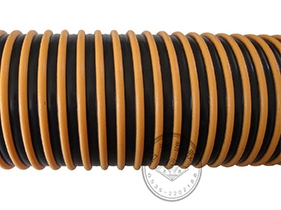Except for a few SBR, most SBR products are flammable or combustible raw materials like natural rubber. At this stage, the key choice is to add halogen-free flame retardant or flame retardant filler and blend with fire retardant materials to improve Sandblasting hose Flame retardant grade. In addition, it is also a reasonable way to let people have flame retardant functional groups in a single unit when converging. Improving the cross-linking density of sandblasting hose is also harmful to flame retardancy. Sandblasting hose The flame-retardant technology is briefly described in detail below.
1. Nitrogen compound sandblasting hose
Nitrogen compound sandblasting hose includes NR, SBR, BR, IIR, EPR, EPDM, etc. Although NBR does not belong to nitrogen compound sandblasting hose, its flame retardant technology is very similar to that of nitrogen compound sandblasting hose, so it belongs to nitrogen compound sandblasting hose.
The flame retardant grade of nitrogen compound sandblasting hose is about 19~21, and the decomposition reaction temperature range is 200~500 ° C. Its high temperature resistance and flame retardant grade are generally weak. Most of the dissolved substances during ignition are combustible gases. The following technical characteristics are often selected for the flame retardancy of this type of sandblasting hose:
Blending with flame retardant polymer compounds, such as polyethylene, gasified high-pressure polyethylene, chlorosulfonated high-pressure polyethylene, butadiene vinyl acetate and other polymer compounds, can moderately improve the flame retardant level of nitrogen compound sandblasting hose. When blending, we should pay attention to the problems of miscibility and co chemical crosslinking.

In addition, halogen-free flame retardant is an effective way to improve the flame-retardant level of nitrogen compound sandblasting hose, and halogen-free flame retardant is used to further improve the actual effect of flame retardancy with synergy. The most common halogen-free flame retardants are organic chemical halogen-free flame retardants, in which perchlorocyclopentadecane, decabromodiphenyl ether, chlorinated paraffin 52, etc. are widely used. In addition, antimony trioxide is the majority of inorganic flame retardants used, followed by zinc borate, hydrated aluminum trioxide, ammonium gasification, etc. During application, it should be noted that the halogen-free flame retardants should not contain dispersed halogens. During production, the dispersed halogens will erode machine equipment and abrasives, which will have a negative impact on the electrical performance and embrittlement characteristics of sandblasting hose. In addition, pay attention to the negative impact of the use of halogen-free flame retardant on the physical properties of sandblasting hose.
In addition, flame-retardant inorganic fillers such as calcium bicarbonate, clay, light calcium powder, white carbon black, aluminum chloride, etc. are added to minimize the proportion of flammable organic chemical substances. Calcium bicarbonate and aluminum oxynitride have thermoelectric effect when dissolved. This kind of method will reduce some physical and physical properties of plastic particles, and the filling amount cannot be very large.
The experiment of increasing the cross-linking density of sandblasting hose confirmed that increasing the cross-linking density of sandblasting hose can improve its flame retardant grade. Therefore, the flame-retardant grade of sandblasting hose can be improved. This may be caused by the temperature rise of plastic particle decomposition reaction. This kind of method has been used in EPDM.
Bittern Sandblasting hose : Halogen element is contained in the halogen-containing sandblasting hose, the flame retardant grade is generally between 28 and 45, and the flame retardant grade of FPM is even above 65. Generally, the higher the composition of halogen bulb in the halogen-containing sandblasting hose, the higher the flame retardant grade. This kind of sandblasting hose has a high flame retardant grade, and the flame will extinguish itself. Therefore, its flame retardancy is easier to solve than nitrogen compound sandblasting hose. In order to further improve the flame-retardant grade of halogen-containing sandblasting hose, halogen-free flame retardant can be added.
Heterochain sandblasting hose: the most symbolic sandblasting hose of this kind is dimethyl silica gel, with a flame retardant rating of 25 or lower, and a decomposition reaction temperature of 400~6001:. In fact, the way of flame retardancy is to increase the decomposition reaction temperature, increase the sediment during decomposition reaction, and alleviate the rate of combustible gas.



